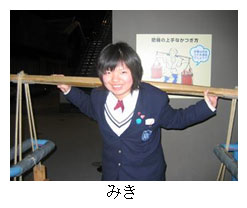
|
Title |
制服のいい点とよくない点 |
|
Unit/Activity No. |
Fashion/Activity 8 |
|
Topic |
Clothing, school |
|
Function |
Expressing opinions, express reasons |
|
Focus |
Read and express opinions about school uniform |
I. BACKGROUND INFORMATION FOR TEACHERS
Teacher Instructions
1. 1) 便利です。できます。にくいです。
2) つまらないです。しかられます。できません。連帯感
2.
|
みき |
|
|
制服のいい点 |
制服のよくない点 |
|
|
|
やすひろ |
|
|
制服のいい点 |
制服のよくない点 |
|
|
3.
1) それに 2) でも
4. (Sample answers)
1) ふとります
2) 目が悪くなります
3) おなかが痛くなります
II. STUDENT ACTIVITY HANDOUTS
Handout 1
1. Two Japanese high school students, Miki and Yasuhiro, are talking about their school uniforms. Choose the most appropriate portion from the parenthesis to complete the sentences below.
1)

制服があると、毎朝、服をえらば1なくてもいいから、けっこう(不便です。/ 便利です。)それに、服のことを考えなくてもいいから、勉強に集中2(できます。/ できません。)でも、女の子はスカート をはかなくてはいけませんし、スカートは長くて 、動き(にくいです。/ やすいです。)
2)

制服は毎日同じ服ばかり着て、好きな服が着られないから、(つまらないです。/ たのしいです。)ぼくの学校では、制服の規則3がたくさんあって、規則を守らない4と、すぐ先生に(ほめられます。/ しかられます。)それに、制服を着ていると、どの学校の学生かすぐわかるから*、学校の行き帰りに悪いことが(できません。/ できます。)でも、みんなと同じ制服を着ていると、同じ学校の仲間5だという(連帯感6/ 個性7)がでます。
*Each high school has its own uniform.
<Useful Vocabulary>
|
1. えらぶ:choose |
2. 集中できる:be able to concentrate |
|
3. きそく:rule |
4. まもる:be obedient to |
|
5. なかま:fellow |
6. れんたいかん:a sense of solidarity |
|
7. こせい:individuality |
2. What are the positive and negative points about the school uniforms Miki and Yasuhiro mentioned?
|
みき |
|
|
制服のいい点(てん) |
制服のよくない点 |
|
|
|
やすひろ |
|
|
制服のいい点(てん) |
制服のよくない点 |
|
|
|
3. The two conjugations (i.e. expressions to connect sentences) Miki and Yasuhiro are using are useful for expressing your opinions. Find them from the text above.
1) _________ is used when introducing an additional statement.
2) _________ is used when introducing a contradictory statement.
4. The particle ‘と’ expresses a condition (phrase before ‘と’) and natural consequences from the condition (phrase after ‘と’). See the following examples:
規則を守らないと、すぐ先生にしかられます。
制服を着ていると、どの学校の学生かすぐ分かります。
Complete the sentences below by supplying with natural consequences.
1) ファーストフードばかり食べていると、________________。
2) 暗い所で本を読むと、________________________。
3) 食べすぎると、___________________________。
Handout 2
5. Work in pairs. Imagine that you wear a school uniform at school during the weekdays; how do you think wearing a uniform would affect you and your classmates? Discuss what kind of positive effects wearing a school uniform might have as well as possible negative effects. Write three of each down.

1.
2.
3.

1.
2.
3.
6. Switch pairs. Using the conjugations above, present the positive and negative effects you and your partner identified.
III. VISUAL AIDS FOR TEACHERS
For the visual aid, make a transparency of Handout 1.